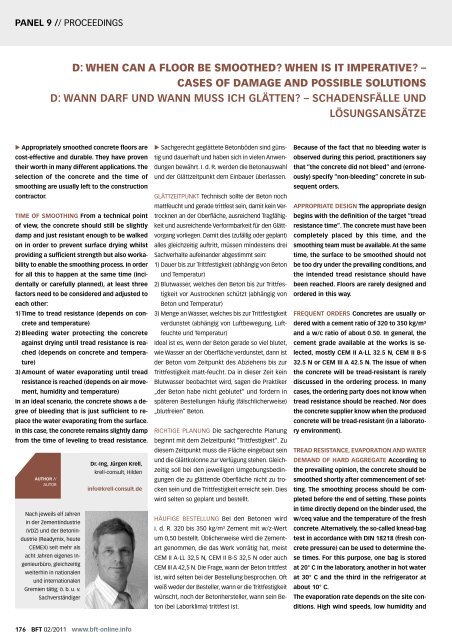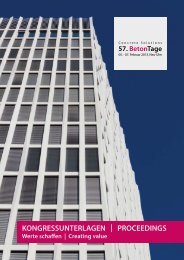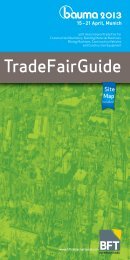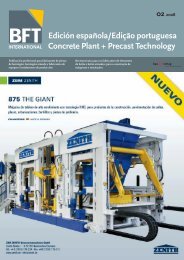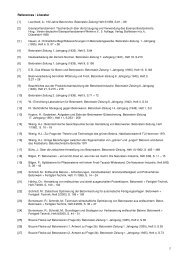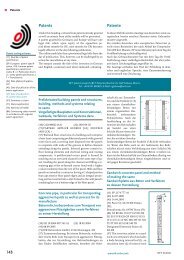Tagungsband - BFT International
Tagungsband - BFT International
Tagungsband - BFT International
Sie wollen auch ein ePaper? Erhöhen Sie die Reichweite Ihrer Titel.
YUMPU macht aus Druck-PDFs automatisch weboptimierte ePaper, die Google liebt.
PANEL 9 // PROCEEDINGS<br />
� Appropriately smoothed concrete floors are<br />
cost-effective and durable. They have proven<br />
their worth in many different applications. The<br />
selection of the concrete and the time of<br />
smoothing are usually left to the construction<br />
contractor.<br />
TIME OF SMOOTHING From a technical point<br />
of view, the concrete should still be slightly<br />
damp and just resistant enough to be walked<br />
on in order to prevent surface drying whilst<br />
providing a sufficient strength but also worka-<br />
bility to enable the smoothing process. In order<br />
for all this to happen at the same time (inci-<br />
dentally or carefully planned), at least three<br />
factors need to be considered and adjusted to<br />
each other:<br />
1) Time to tread resistance (depends on con-<br />
crete and temperature)<br />
2) Bleeding water protecting the concrete<br />
against drying until tread resistance is rea-<br />
ched (depends on concrete and tempera-<br />
ture)<br />
3) Amount of water evaporating until tread<br />
resistance is reached (depends on air move-<br />
ment, humidity and temperature)<br />
In an ideal scenario, the concrete shows a de-<br />
gree of bleeding that is just sufficient to re-<br />
place the water evaporating from the surface.<br />
In this case, the concrete remains slightly damp<br />
from the time of leveling to tread resistance.<br />
AUTHOR //<br />
AUTOR<br />
D: WHEN CAN A FLOOR BE SMOOTHED? WHEN IS IT IMPERATIVE? –<br />
CASES OF DAMAGE AND POSSIBLE SOLUTIONS<br />
D: WANN DARF UND WANN MUSS ICH GLÄTTEN? – SCHADENSFÄLLE UND<br />
LÖSUNGSANSÄTZE<br />
Nach jeweils elf Jahren<br />
in der Zementindustrie<br />
(VDZ) und der Betonin-<br />
dustrie (Readymix, heute<br />
CEMEX) seit mehr als<br />
acht Jahren eigenes In-<br />
genieurbüro, gleichzeitig<br />
weiterhin in nationalen<br />
und internationalen<br />
Gremien tätig; ö. b. u. v.<br />
Sachverständiger<br />
Dr.-Ing, Jürgen Krell,<br />
krell-consult, Hilden<br />
info@krell-consult.de<br />
176 <strong>BFT</strong> 02/2011 www.bft-online.info<br />
� Sachgerecht geglättete Betonböden sind güns-<br />
tig und dauerhaft und haben sich in vielen Anwen-<br />
dungen bewährt. I. d. R. werden die Betonauswahl<br />
und der Glättzeitpunkt dem Einbauer überlassen.<br />
GLÄTTZEITPUNKT Technisch sollte der Beton noch<br />
mattfeucht und gerade trittfest sein, damit kein Ver-<br />
trocknen an der Oberfläche, ausreichend Tragfähig-<br />
keit und ausreichende Verformbarkeit für den Glätt-<br />
vorgang vorliegen. Damit dies (zufällig oder geplant)<br />
alles gleichzeitig auftritt, müssen mindestens drei<br />
Sachverhalte aufeinander abgestimmt sein:<br />
1) Dauer bis zur Trittfestigkeit (abhängig von Beton<br />
und Temperatur)<br />
2) Blutwasser, welches den Beton bis zur Trittfes-<br />
tigkeit vor Austrocknen schützt (abhängig von<br />
Beton und Temperatur)<br />
3) Menge an Wasser, welches bis zur Trittfestigkeit<br />
verdunstet (abhängig von Luftbewegung, Luft-<br />
feuchte und Temperatur)<br />
Ideal ist es, wenn der Beton gerade so viel blutet,<br />
wie Wasser an der Oberfläche verdunstet, dann ist<br />
der Beton vom Zeitpunkt des Abziehens bis zur<br />
Trittfestigkeit matt-feucht. Da in dieser Zeit kein<br />
Blutwasser beobachtet wird, sagen die Praktiker<br />
„der Beton habe nicht geblutet“ und fordern in<br />
späteren Bestellungen häufig (fälschlicherweise)<br />
„blutfreien“ Beton.<br />
RICHTIGE PLANUNG Die sachgerechte Planung<br />
beginnt mit dem Zielzeitpunkt “Trittfestigkeit“. Zu<br />
diesem Zeitpunkt muss die Fläche eingebaut sein<br />
und die Glättkolonne zur Verfügung stehen. Gleich-<br />
zeitig soll bei den jeweiligen Umgebungsbedin-<br />
gungen die zu glättende Oberfläche nicht zu tro-<br />
cken sein und die Trittfestigkeit erreicht sein. Dies<br />
wird selten so geplant und bestellt.<br />
HÄUFIGE BESTELLUNG Bei den Betonen wird<br />
i. d. R. 320 bis 350 kg/m³ Zement mit w/z-Wert<br />
um 0,50 bestellt. Üblicherweise wird die Zement-<br />
art genommen, die das Werk vorrätig hat, meist<br />
CEM II A-LL 32,5 N, CEM II B-S 32,5 N oder auch<br />
CEM III A 42,5 N. Die Frage, wann der Beton trittfest<br />
ist, wird selten bei der Bestellung besprochen. Oft<br />
weiß weder der Besteller, wann er die Trittfestigkeit<br />
wünscht, noch der Betonhersteller, wann sein Be-<br />
ton (bei Laborklima) trittfest ist.<br />
Because of the fact that no bleeding water is<br />
observed during this period, practitioners say<br />
that “the concrete did not bleed” and (errone-<br />
ously) specify “non-bleeding” concrete in sub-<br />
sequent orders.<br />
APPROPRIATE DESIGN The appropriate design<br />
begins with the definition of the target “tread<br />
resistance time”. The concrete must have been<br />
completely placed by this time, and the<br />
smoothing team must be available. At the same<br />
time, the surface to be smoothed should not<br />
be too dry under the prevailing conditions, and<br />
the intended tread resistance should have<br />
been reached. Floors are rarely designed and<br />
ordered in this way.<br />
FREQUENT ORDERS Concretes are usually or-<br />
dered with a cement ratio of 320 to 350 kg/m³<br />
and a w/c ratio of about 0.50. In general, the<br />
cement grade available at the works is se-<br />
lected, mostly CEM II A-LL 32.5 N, CEM II B-S<br />
32.5 N or CEM III A 42.5 N. The issue of when<br />
the concrete will be tread-resistant is rarely<br />
discussed in the ordering process. In many<br />
cases, the ordering party does not know when<br />
tread resistance should be reached. Nor does<br />
the concrete supplier know when the produced<br />
concrete will be tread-resistant (in a laborato-<br />
ry environment).<br />
TREAD RESISTANCE, EVAPORATION AND WATER<br />
DEMAND OF HARD AGGREGATE According to<br />
the prevailing opinion, the concrete should be<br />
smoothed shortly after commencement of set-<br />
ting. The smoothing process should be com-<br />
pleted before the end of setting. These points<br />
in time directly depend on the binder used, the<br />
w/ceq value and the temperature of the fresh<br />
concrete. Alternatively, the so-called knead-bag<br />
test in accordance with DIN 18218 (fresh con-<br />
crete pressure) can be used to determine the-<br />
se times. For this purpose, one bag is stored<br />
at 20° C in the laboratory, another in hot water<br />
at 30° C and the third in the refrigerator at<br />
about 10° C.<br />
The evaporation rate depends on the site con-<br />
ditions. High wind speeds, low humidity and


